A Local Explains 13 Must-Try Pastries In Portugal And Where To Find Them
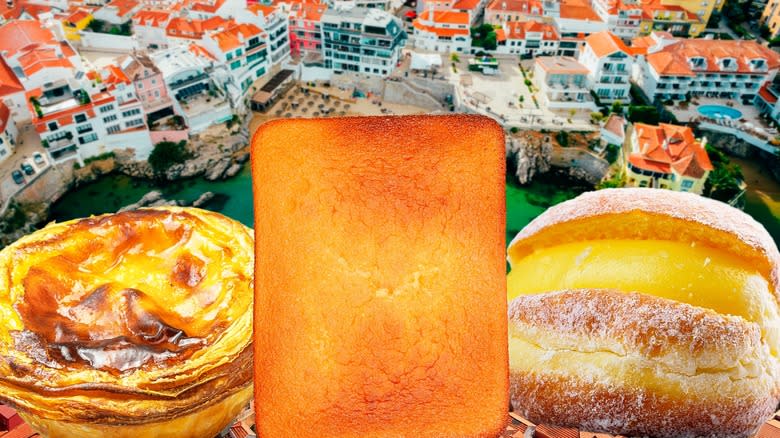
- Oops!Something went wrong.Please try again later.
There's no shortage of European countries with excellent pastries. France gives us treats like macarons, éclairs, and madeleines. Italy brings cannoli, babà al rum, and biscotti. And let's not forget Austria: the home of Linzer torte, Sachertorte, and apple strudel. Yet, one country that's often left out of pastry discussions is Portugal. Whether that's due to its small size, somewhat secluded location in Europe, or its 48-year dictatorship, Portuguese pastries haven't garnered as much attention as their European counterparts. Nonetheless, Portugal's pastry culture is rich, diverse, and worth a second look.
Several key factors have shaped the country's pastry tradition. One was the country's prosperous sugar trade on Madeira Island and with Brazil, a former colony. Another came from the creativity of monks, Catholic nuns, and home bakers, all of whom put a unique spin on these sweet creations. As a result, Portugal's modern-day pastry offerings present a delightful array of choices. Having lived in Lisbon for a year and a half and indulged in countless pastry adventures along the way, I'm excited to share which Portuguese treats are truly worth your time, along with some top recommendations for where to find them.
Read more: 25 Most Popular Snacks In America Ranked Worst To Best
Pastel De Nata
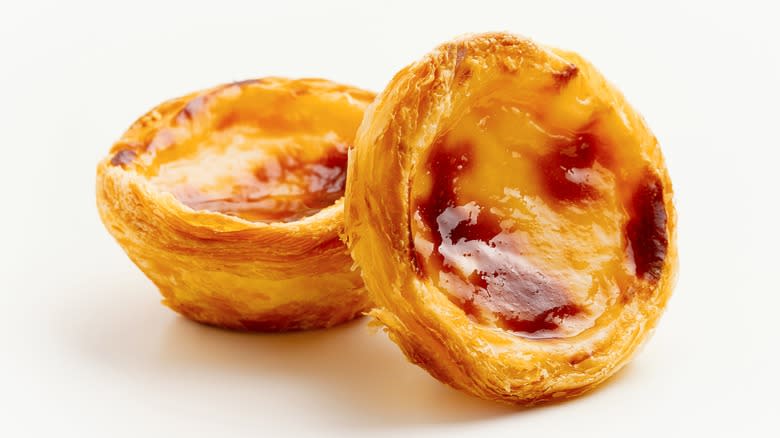
Even if you haven't explored Portugal or its pastry scene, chances are you've heard of (or tasted) the famous pastel de nata (singular for pastéis de nata). These delightful treats, which translate to "cream pastries," can be found as far away from Portugal as London, Japan, and New York City. With their crispy, flaky pastry crusts filled with rich egg custard caramelized to perfection and finished with a dusting of cinnamon and powdered sugar, what's not to love?
The origins of pastel de nata can be traced back to the 18th century, when resourceful monks at the Jerónimos Monastery in Lisbon turned surplus egg yolks, left over from starching clothes, into sweet creations. Every guidebook will tell you to sample them at Fábrica de Pastéis de Belém, a pastry shop next door to the monastery. But take it from a local -- the huge crowds, 45-minute waits, and rushed service detract from the experience. My advice is to try them at Manteigaria instead. This chain has branches throughout Lisbon, including right across the street from Fabrica de Pastéis de Belém. There's hardly ever a line, the pastries are just as indulgent, and you'll be served with a smile.
Pastel De Feijão
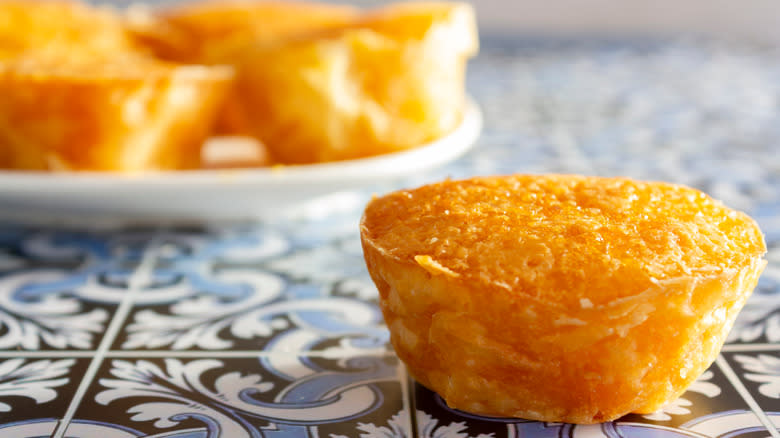
If you're well-acquainted with not-too-sweet Asian desserts, the concept of combining pastries with beans won't sound strange to you. However, it might be a bit peculiar for the uninitiated. If you find yourself in the latter group, try to keep an open mind before trying pastel de feijão (bean pastry). These small, round pastries might be mistaken for their more famous counterpart, the pastel de nata. However, their flavors couldn't be more different. Pastel de feijão features a delicate pastry shell filled with a jam made with white beans, sugar, egg yolks, and almonds. As with many of Portugal's pastries, a bitter espresso best complements the extreme sweetness.
This recipe dates back to the late 19th century in Torres Vedras, a town located approximately 30 miles north of Lisbon. These treats quickly gained popularity and were transported to the capital by train before finding their way into pastry shops across the city. One such establishment was Confeiteria Nacional, which has been serving an array of pastries since opening in 1829. For that reason alone, it's the best place to try pastel de feijão in Portugal.
Pão-de-ló
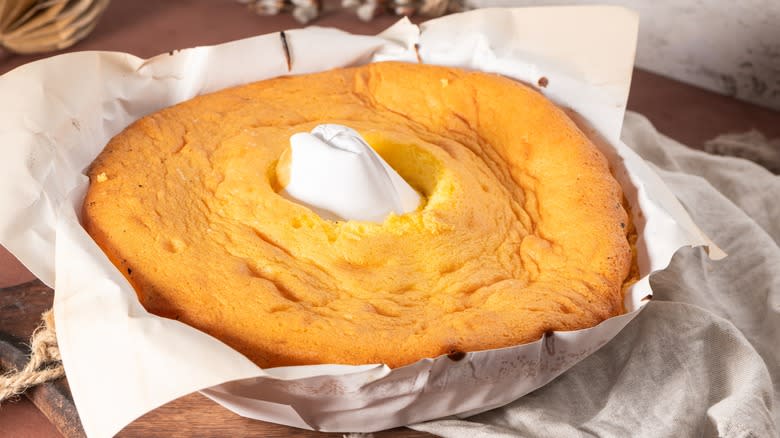
Pão-de-ló is Portugal's take on sponge cake. It joins the ranks of Italian pan di Spagna, French génoise, and Sephardic pan de Espana. As the names suggest, all these cakes trace their roots back to 16th-century Renaissance Spain. For that reason, you may also see it called pão de Espanha (bread from Spain) or pão de Castela (bread from Castile). This recipe even journeyed beyond Europe and took on new forms, including evolving into what is now known as castella in Japan.
While the core ingredients of eggs, sugar, and flour remain consistent, there are many regional variations across Portugal. For example, Guimarães, a city in Northern Portugal, integrates lemon zest into its version of the cake. Travel a bit south to Vizela, where the typically round cake is transformed into a rectangle and drenched in sugar syrup. Then there's pão-de-ló de Ovar, a moist, gooey variation that boasts a Protected Geographical Indication from the European Union.
Although this cake is traditionally enjoyed during Christmas and Easter, it can be found year-round. A Padaria Portuguesa, a local café chain with outlets throughout the greater Lisbon area, is one reliable spot. But for those eager to taste the famed Ovar version, I recommend Confeitaria Cardoso or Pão-de-ló São Luiz.
Ovos Moles De Aveiro
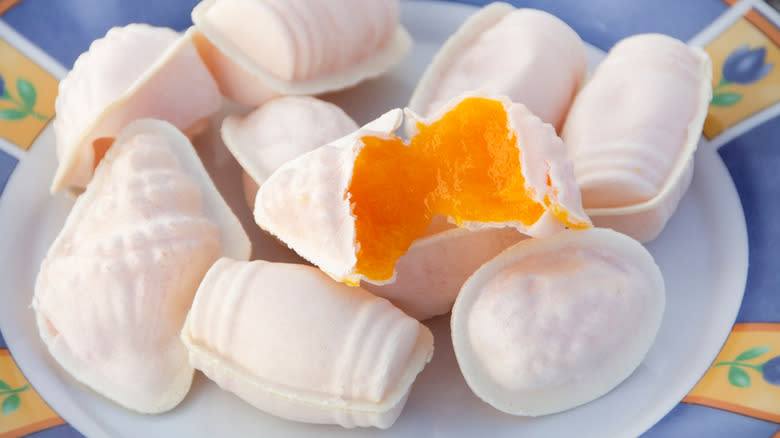
Portuguese pastries often have deep connections to their places of origin, and ovos moles are no exception. This egg yolk-based pastry proudly hails from Aveiro, a charming town in western Portugal. Like many other Portuguese pastries, ovos moles emerged from the creative kitchens of a convent, where thrifty nuns repurposed leftover egg yolks, a byproduct of their habit-starching endeavors, into treats. Mixing these yolks with sugar and water birthed a decadent filling encased in a dough identical to Catholic communion wafers.
What sets ovos moles apart from other pastries is their shape. Seashells, clams, barrels, and nuts are common, each reflecting Aveiro's history and culture. Seashells and clams nod to the town's coastal location, barrels pay tribute to its salt-carrying vessels of centuries past, and nuts reflect local agriculture.
If you have a hankering for these treats, a visit to Aveiro is a must, as it's the only place to get authentic pastries. But even within Aveiro, you've got to choose wisely. Ovos moles bear a Protected Geographical Indication from the European Union, so they're hard to find outside of the region. For the most authentic experience, I recommend stopping by Confeitaria Peixinho. The shop was established in 1856 and is one of the longest-running retailers of one of these timeless sweets.
Queque
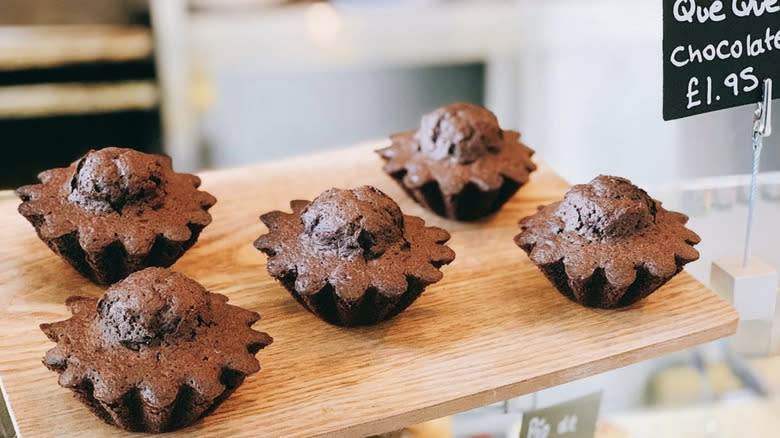
While the spelling might throw you off, "queue," pronounced "ke-ki," serves as Portugal's version of muffins. But you wouldn't know that looking at them. Instead of the domed, mushroom-like shape of muffins in other countries, Portuguese queques have a smaller, higher dome and look more like a crude rendition of suns or flowers. They're flavored simply, reminiscent of pão-de-ló, the Portuguese sponge cake, but with the crucial addition of butter. This ingredient gives them a dense texture and a distinct creamy, slightly salty taste. You'll often find a version with walnuts, too.
Queques might not win any beauty contests or innovation awards, but what they lack in flair, they make up for in reliability. I always order them from A Padaria Portuguesa, a chain with 70 branches in Lisbon and its suburbs, but they're pretty much the same everywhere. No matter where you get them, queques are a tasty addition to your morning coffee or afternoon tea.
Bolo De Arroz
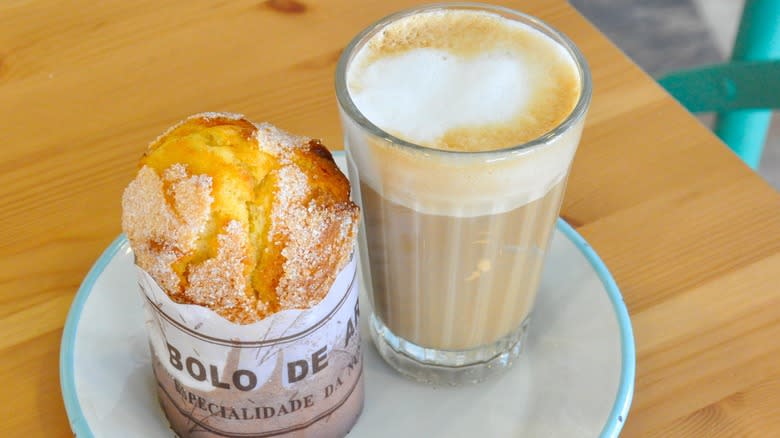
Entering a bakery in a foreign country where you're unfamiliar with the offerings and don't speak the language is daunting. Without another option, you might resort to using Google Lens to identify pastries, gesturing your preferences to the amused staff, and hoping for the best. Thankfully, Portugal's bolo de arroz ("cake of rice") eliminates the guesswork when it comes to choosing your next breakfast or snack. These muffin-like delights are served in paper wrappers clearly labeled with their name.
The name "bolo de arroz" refers to rice flour, a key ingredient that gives the pastry its light, fluffy texture reminiscent of sweet cornbread. Unfortunately for gluten-free folks, though, these treats also contain all-purpose flour. A generous amount of butter keeps them moist and adds rich, creamy flavor notes. The ingredient list also features lemon zest, which provides a subtle hint of freshness. However, what truly sets them apart is a crispy and sugar-coated crust, which offers a delightful contrast to the soft muffins underneath.
Travesseiros De Sintra
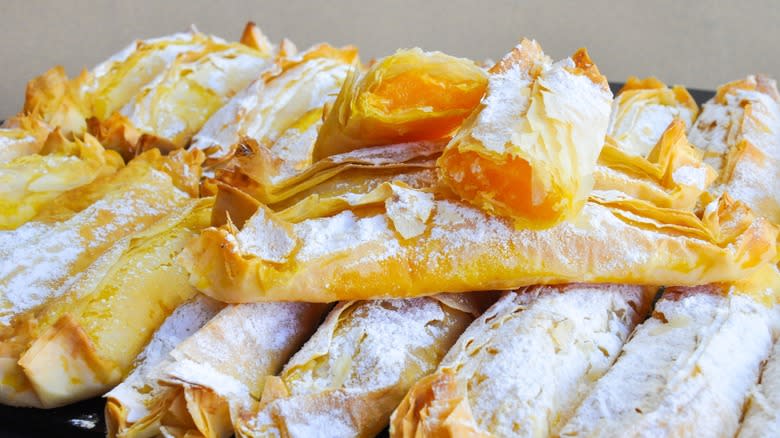
Just a 40-minute train journey from Lisbon lies Sintra, a picturesque town nestled amidst hills and lush greenery that once served as a royal sanctuary. While most visitors flock to the area to see the palaces, the town itself boasts a charming array of local shops, eateries, and cafés that offer a taste of local specialties. Among these are the famed travesseiros de Sintra, or "Sintra pillows" — delicate puff pastries filled with a blend of egg yolks, almonds, sugar, and a closely guarded secret ingredient.
Although several shops in Sintra offer travesseiros, none are as renowned as Casa Piriquita. This family-owned bakery was established in 1862 and has stood the test of time, surviving the two world wars and Portugal's dictatorship. Piriquita initially gained favor with King Carlos I for its queijada, a fresh cheese-based pastry. What kept it going was the ingenuity of Constância Luísa Cunha, the daughter of the bakery's founder. In the 1940s, she resurrected an old recipe for travesseiros that developed into the iconic pastry visitors know and love to this day.
Jesuíta
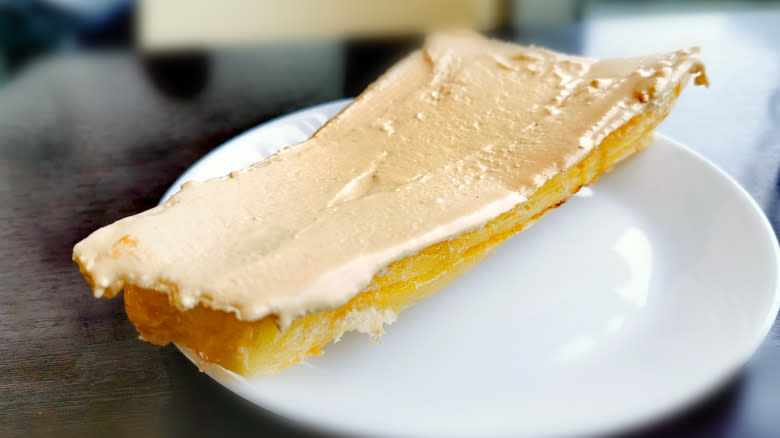
Jesuítas are triangular puff pastries filled with a cinnamon-infused egg yolk cream, topped with an egg white glaze. Some variations feature toasted almonds and powdered sugar toppings. As the name suggests, this Portuguese pastry has religious roots and belongs to the category of doces conventuais, or convent sweets. These desserts, which originate from recipes developed by monks or nuns, typically feature three main ingredients: water, sugar, and egg yolks. Among the more than 150 pastries in this group are well-known treats like pastel de nata, pão-de-ló, and ovos moles.
According to legend, Jesuítas were created over a century ago by a Spanish pastry chef who collaborated with Jesuit priests in Bilbao, Spain, before introducing the recipe to Confeitaria Moura in Santo Tirso, Portugal. The pastries' triangular shape and beige color were said to resemble the robes worn by Jesuit priests.
For those with a sweet tooth willing to embrace a bit of messiness, I recommend trying Jesuítas at Confeitaria Moura, which has been making the treats since 1892. The brand has three locations in Porto and Santo Tirso.
Pão De Deus
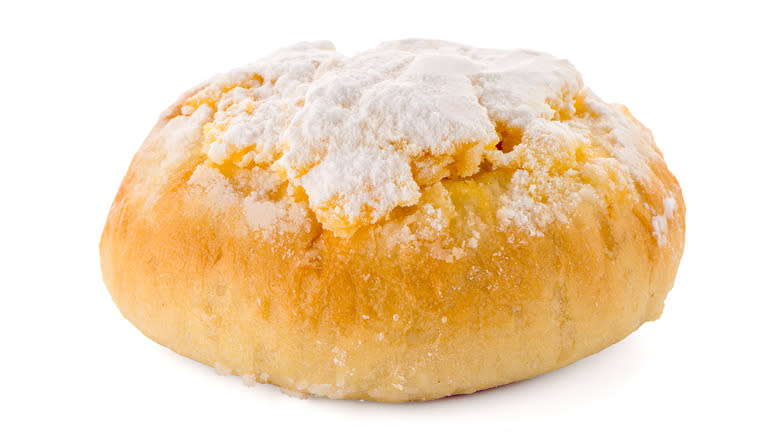
With a name like "bread of God," it's natural to expect something divine from this pastry. I can't offer any guarantees, but if you're a fan of sweet bread and coconut, there's a good chance you'll be enchanted from the very first bite. This pastry comprises a brioche-like bun crowned with a grated coconut, sugar, and egg crust. Portuguese folks enjoy it for breakfast or as an afternoon snack, either as is or filled with ham and cheese (known as "misto," meaning "mixed").
Though it's now a daily indulgence, the origins of this bread trace back to All Saints' Day on November 1st. Following Lisbon's tragic 1755 All Saints' Day earthquake, hungry residents went door to door with the plea, "pão, por Deus" ("bread, for God's sake"). Those able to offer something did so willingly, and this generous spirit inspired the pastry's name.
A Padaria Portuguesa, a popular chain, specializes in this bread. Locals love it for its slightly undercooked texture and perfectly balanced sweetness.
Bola De Berlim
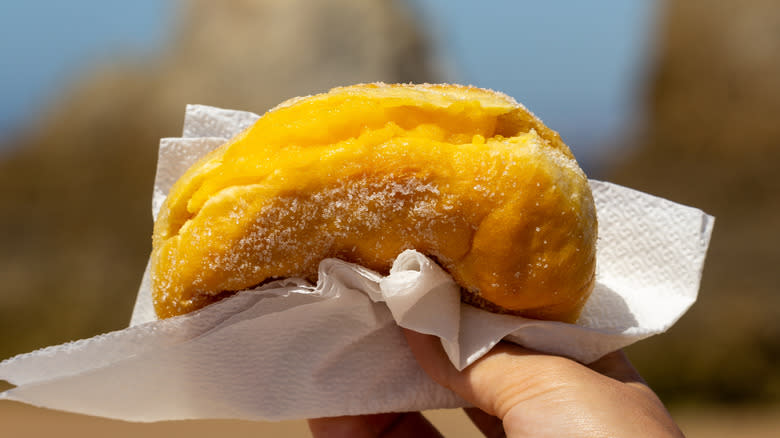
When you think of beach snacks, what comes to mind? Probably ice cream, fresh fruit, and perhaps even hot dogs. Donuts likely don't make the list — unless you happen to be in Portugal. One of the country's favorite seaside treats is bola de Berlim, a hole-less, deep-fried donut filled with egg custard often sold by street vendors.
During World War II, Portugal's neutral status attracted Jewish refugees from Germany. Many ended up working in food service and shared the recipe for these "Berlin balls." Over time, the recipe evolved to suit local tastes, including transitioning from the original jam-filled version to a custard-filled rendition suited to the Portuguese palate. The shift from cafés to beaches was also natural once people discovered how much the salty air enhanced the sweetness of the sugar-topped pastry. Today, alongside the classic plain and custard-filled versions, you can find bola de Berlim filled with Nutella, dulce de leche, lemon cream, and more. If you can't make it to the beach, grab one from Sacolinha or Orabolas in Lisbon.
Queijada
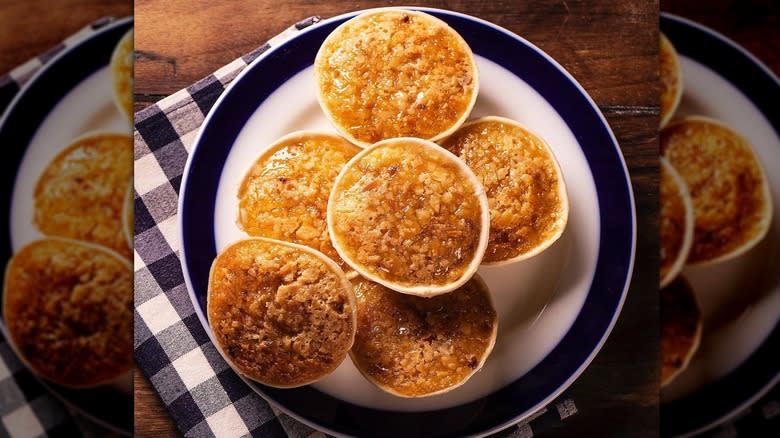
Before paper currency became standardized, people used all sorts of unconventional items for trade: salt, animal skins, and cheese, just to name a few. But you may have never heard of pastries being used as currency. In the 13th century, the land we now know as Portugal was divided into kingdoms, and residents had to pay the king to live on the land. Instead of money, Sintra inhabitants paid with queijadas — small cheesecake-like pastries with crunchy dough shells. This tasty form of payment lasted until the mid-18th century.
The fact that queijadas were accepted as legal tender underscores their deliciousness. The appeal lies in requeijão, a locally sourced cow's milk cheese akin to ricotta, which imparts a unique flavor reflective of the region's terroir. The closely guarded recipe adds to the mystique. While the ingredients — requeijão, sugar, eggs, and cinnamon — are standardized, their exact proportions are shrouded in secrecy.
If you think the original queijadas sound amazing, there are also variations made with carrot, orange, nuts, or coconut. You can try them at renowned pastry shops like Casa Piriquita or Dona Estefânia, among others in Sintra.
Salame
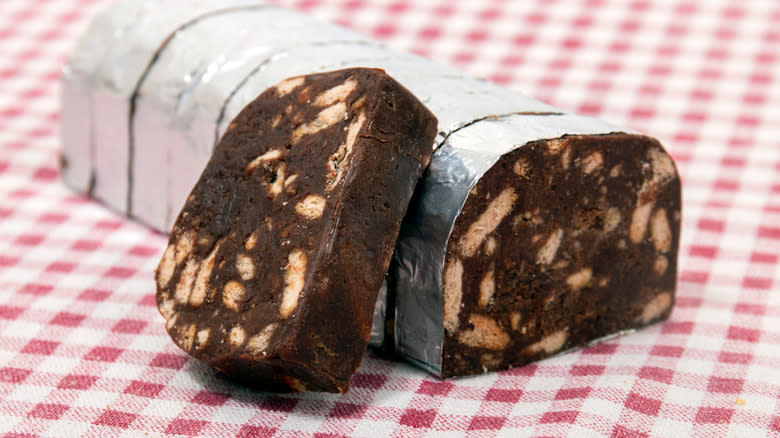
Although its name and cylindrical shape bear a passing resemblance to cured meat, in the world of Portuguese pastries, "salame" takes on a sweeter meaning. Instead of pork, salame is made out of chocolate and crushed biscuits. The mixture of cocoa powder, eggs, sugar, and butter provides the foundation, while tea biscuits — often known as Maria cookies or Marie biscuits — are used to simulate the appearance of fat in traditional salami. Additionally, variations may include chopped almonds or hazelnuts for added crunch.
While most of the pastries on this list are consumed in the morning, salame is almost always reserved for an afternoon pick-me-up, especially when paired with a Portuguese coffee drink. Something else that distinguishes it from other pastries is its limited availability. Based on my experience, your best bet is Salamaria in Lisbon, a shop specializing in the dessert. Here, alongside the classic chocolate version, you'll discover creative riffs ranging from red velvet to Snickers, several of which are vegan.
Toucinho Do Céu
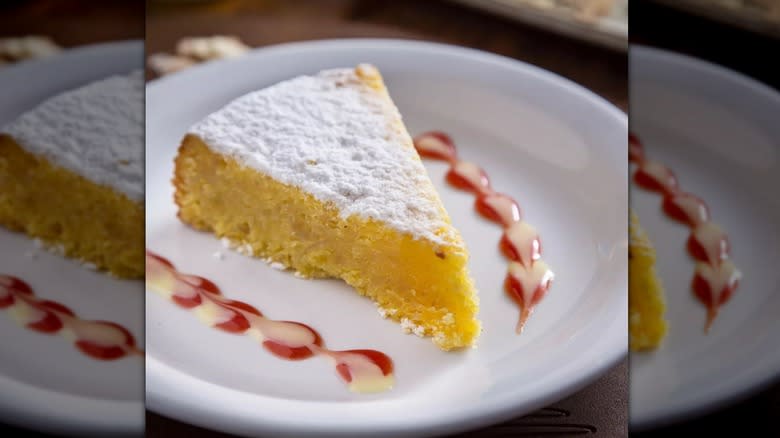
If there's one thing to say about Portuguese pastries, it's that their names are descriptive. Some, like pastel de nata and pastel de feijão, leave little mystery as to their contents. Others, such as travesseiros de Sintra, honor both their birthplace and shape. Then there are intriguing outliers like toucinhos do céu, meaning "bacon of heaven." While the name might not provide much clarity on the pastry's ingredients, it certainly sparks curiosity. After all, when has anything involving bacon ever disappointed?
Unfortunately for all of the pork lovers out there, these confections don't actually contain any bacon. Rather, the name references a key ingredient: lard. In this convent sweet, lard replaces butter -- which showcases Portuguese pastry-making's inventive spirit. Like other desserts in the Portuguese pastry canon, toucinhos do céu were born from the resourcefulness of convent nuns who made treats using the ingredients they had on hand. In addition to lard, toucinho do céu contain sugar, almond flour, orange zest, and lots and lots of egg yolks. The result is a dense, golden torte that's sliced into triangles and dusted with powdered sugar before serving. Try them at Alcôa, a Lisbon pastry shop specializing in convent sweets.
Read the original article on Tasting Table

